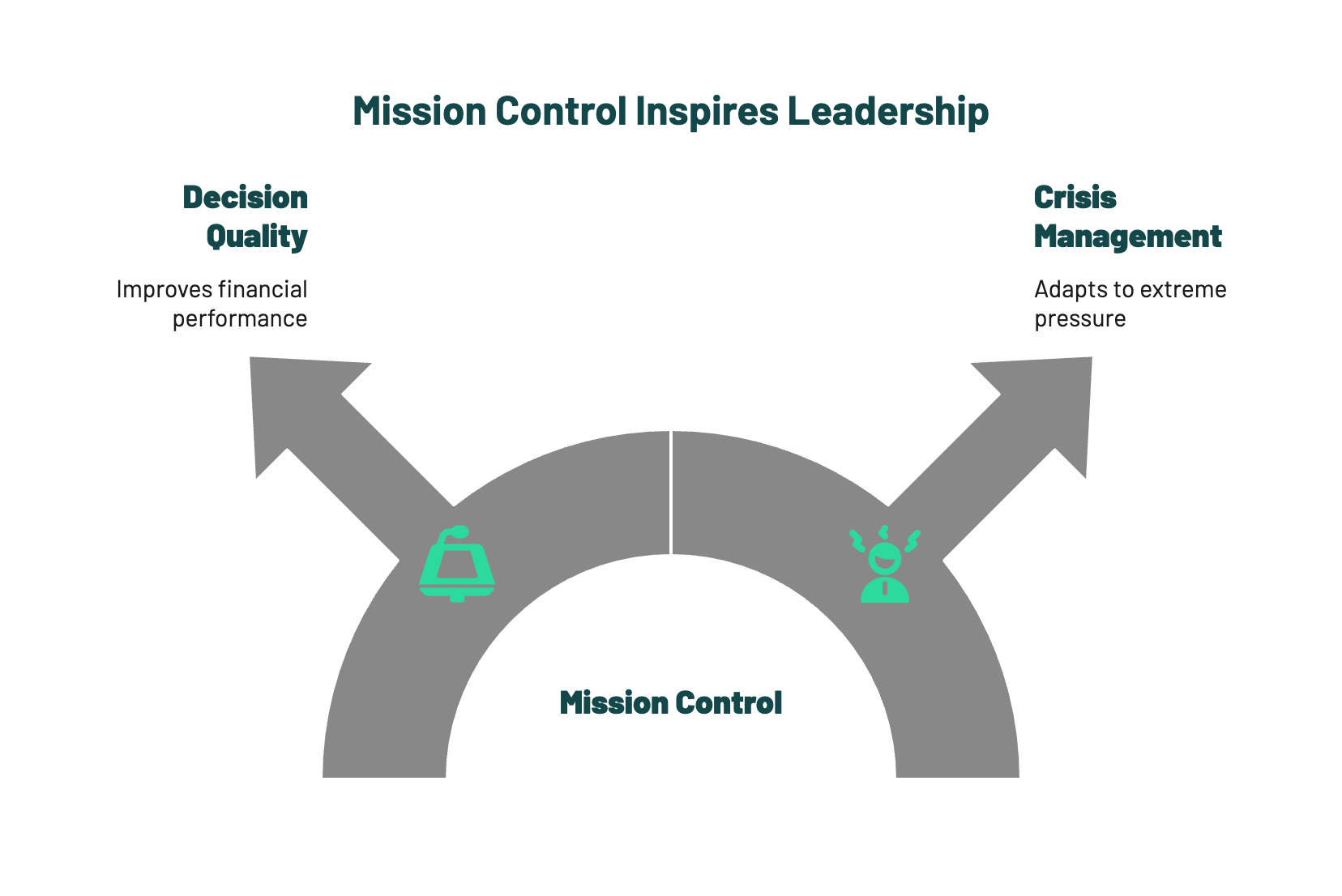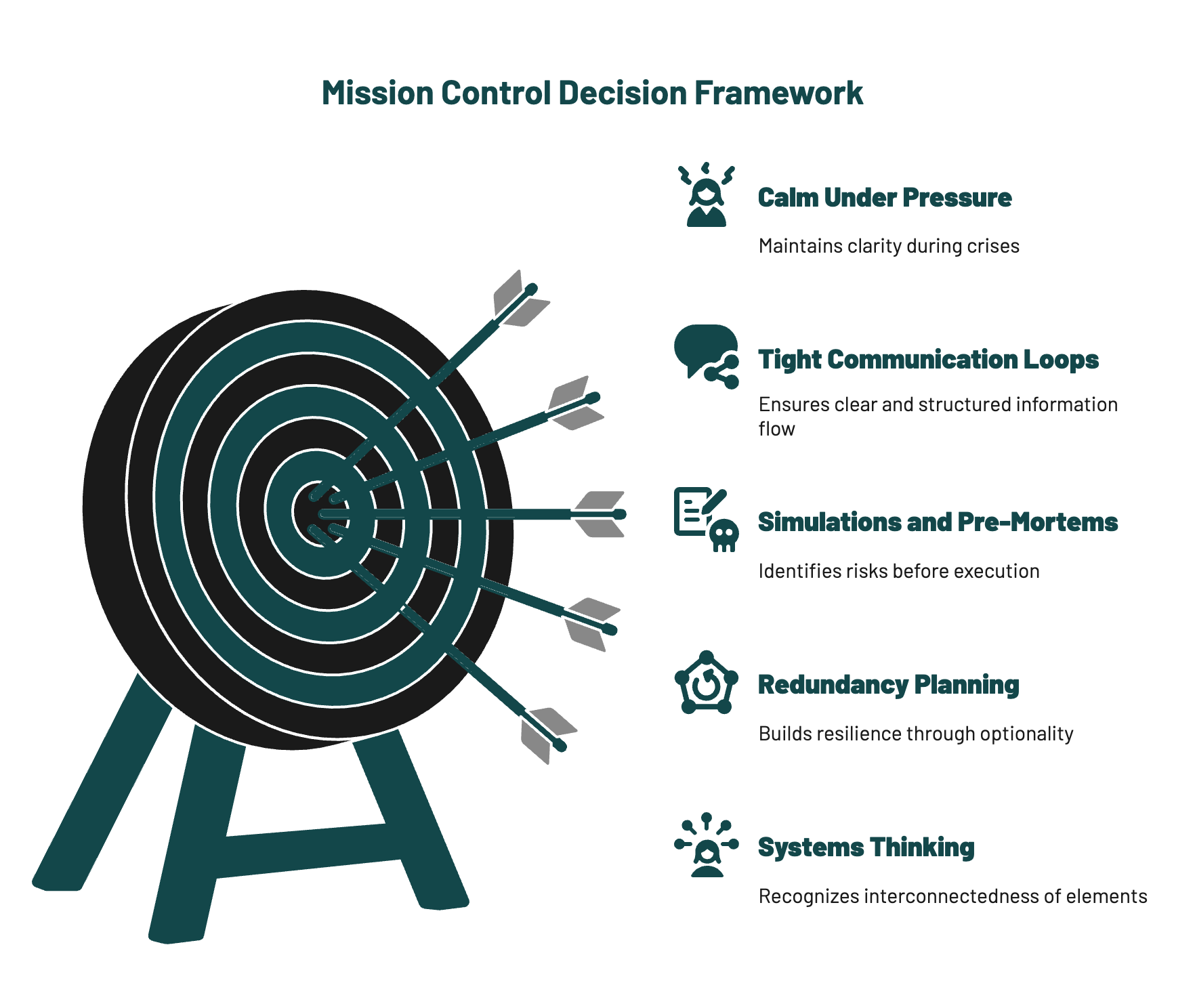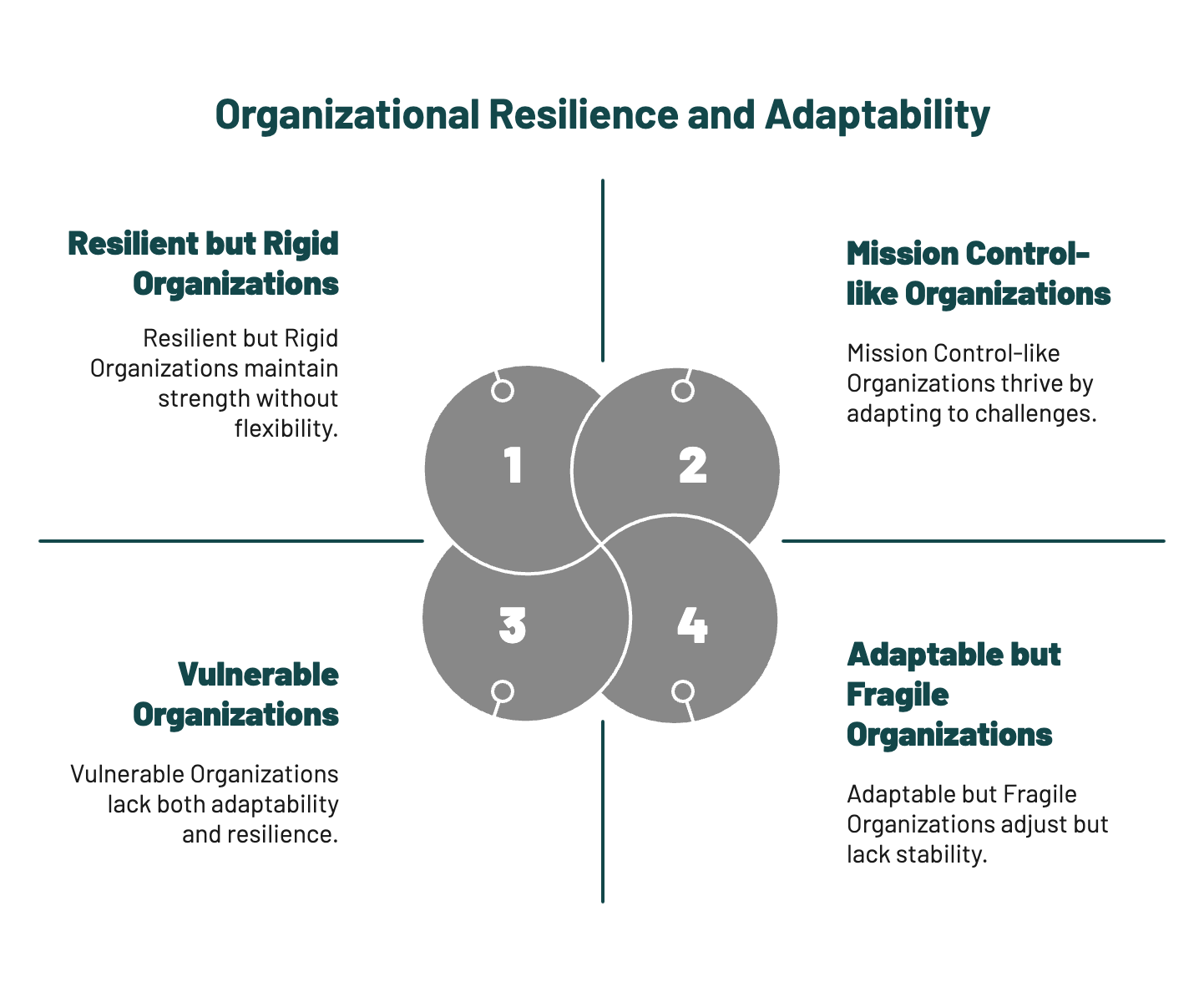Leadership
August 5, 2025
5
Min
Leadership Lessons from NASA Mission Control: Mental Models for High-Stakes Decisions
Mental Model
|
NASA’s Mission Control has been described as “the cathedral of engineering.” It is a place where decisions must blend logic, systems thinking, and human judgement under extreme conditions. When Apollo 13’s oxygen tank exploded in 1970, Flight Director Gene Kranz’s team had to improvise a life-support solution using only the materials available onboard. Kranz’s calm directive became legendary: “Failure is not an option.”
In corporate boardrooms, the crisis may not involve astronauts’ lives, but the pressure feels just as real when shareholder confidence, market position, or organisational survival is at risk. Research from McKinsey suggests that high-quality decision making correlates directly with financial performance, with top-quartile companies making decisions twice as fast as their peers. Mission Control offers a living playbook of mental models leaders can adapt.

We call it The Five Orbit Mental Models – patterns of thinking that NASA engrained into its teams to handle high-stakes choices.
Mission Control sees no isolated problems. Every subsystem – propulsion, navigation, life support – is connected. Leaders who borrow this lens look beyond departmental silos and recognise cascading effects. When a supply chain hiccup hits sales forecasts, the systems thinker asks, “What’s the second- and third-order consequence?”
Reflection prompt: In your last major decision, did you map how one choice rippled across five other functions?
NASA never assumes Plan A will hold. There is always a backup and often a backup for the backup. In leadership, redundancy means building optionality – alternative suppliers, cross-trained teams, multiple data sources. In fast-moving markets, resilience is born from redundancy.
Micro-action: This week, identify one single point of failure in your operation and assign an alternate pathway.
Mission Control runs thousands of simulations before launch. Every failure mode is tested in advance. Business leaders can mirror this with pre-mortems: “Assume our strategy fails – what killed it?” This mindset surfaces hidden risks before they derail execution.
Reflection prompt: If your flagship initiative failed tomorrow, what three blind spots would you wish you had tested earlier?
In Houston, information flows in structured loops. Flight directors don’t debate endlessly; they request crisp go/no-go calls from each console. This clarity avoids ambiguity when seconds matter. Leaders should engineer similarly tight communication in crisis reviews: short, structured inputs, then a decision.
Micro-action: Redesign your next executive meeting to end with explicit “go/no-go” statements, not vague nods.
NASA flight directors are trained to project calm. Anxiety is contagious, but so is composure. Leaders set the emotional temperature of the room. Kranz’s cool leadership in Apollo 13 preserved psychological bandwidth for problem-solving. In business, during market shocks or cybersecurity breaches, calm is often the difference between clarity and chaos.
Micro-action: Practise your “pause and breathe” before delivering direction in moments of tension. Your team will mirror your composure.

How do we turn these lessons into practical routines for leadership teams?
Pro Tip: Document the “decision log” after each high-stakes meeting. NASA’s post-flight reviews are legendary sources of institutional learning.

Prompt 1: If a crisis erupted in your company today, what is the “Mission Control equivalent” team you’d trust to respond?
Prompt 2: Which mental model – systems thinking, redundancy, simulations, communication loops, or calm under pressure – do you most underuse?
Take five minutes to journal on these before your next leadership meeting.
Leaders who embrace these models achieve faster pivots, sharper risk anticipation, and stronger cultures of trust. They create organisations that do not just survive turbulence but convert it into learning. The lesson from Houston is not about technology but about disciplined mental habits applied under stress.

Choose a current strategic initiative and run a pre-mortem with your leadership team. Ask: “What would Mission Control test that we haven’t?”
Team SHIFT
What happens when the room goes quiet, every eye fixed on the data screen, and the margin for error is measured in seconds? For NASA Mission Control, these moments are routine. For leaders in business, they hold a mirror. How do we make decisions under pressure when complexity is high, stakes are existential, and information is incomplete?
NASA’s Mission Control has been described as “the cathedral of engineering.” It is a place where decisions must blend logic, systems thinking, and human judgement under extreme conditions. When Apollo 13’s oxygen tank exploded in 1970, Flight Director Gene Kranz’s team had to improvise a life-support solution using only the materials available onboard. Kranz’s calm directive became legendary: “Failure is not an option.”
In corporate boardrooms, the crisis may not involve astronauts’ lives, but the pressure feels just as real when shareholder confidence, market position, or organisational survival is at risk. Research from McKinsey suggests that high-quality decision making correlates directly with financial performance, with top-quartile companies making decisions twice as fast as their peers. Mission Control offers a living playbook of mental models leaders can adapt.

We call it The Five Orbit Mental Models – patterns of thinking that NASA engrained into its teams to handle high-stakes choices.
Mission Control sees no isolated problems. Every subsystem – propulsion, navigation, life support – is connected. Leaders who borrow this lens look beyond departmental silos and recognise cascading effects. When a supply chain hiccup hits sales forecasts, the systems thinker asks, “What’s the second- and third-order consequence?”
Reflection prompt: In your last major decision, did you map how one choice rippled across five other functions?
NASA never assumes Plan A will hold. There is always a backup and often a backup for the backup. In leadership, redundancy means building optionality – alternative suppliers, cross-trained teams, multiple data sources. In fast-moving markets, resilience is born from redundancy.
Micro-action: This week, identify one single point of failure in your operation and assign an alternate pathway.
Mission Control runs thousands of simulations before launch. Every failure mode is tested in advance. Business leaders can mirror this with pre-mortems: “Assume our strategy fails – what killed it?” This mindset surfaces hidden risks before they derail execution.
Reflection prompt: If your flagship initiative failed tomorrow, what three blind spots would you wish you had tested earlier?
In Houston, information flows in structured loops. Flight directors don’t debate endlessly; they request crisp go/no-go calls from each console. This clarity avoids ambiguity when seconds matter. Leaders should engineer similarly tight communication in crisis reviews: short, structured inputs, then a decision.
Micro-action: Redesign your next executive meeting to end with explicit “go/no-go” statements, not vague nods.
NASA flight directors are trained to project calm. Anxiety is contagious, but so is composure. Leaders set the emotional temperature of the room. Kranz’s cool leadership in Apollo 13 preserved psychological bandwidth for problem-solving. In business, during market shocks or cybersecurity breaches, calm is often the difference between clarity and chaos.
Micro-action: Practise your “pause and breathe” before delivering direction in moments of tension. Your team will mirror your composure.

How do we turn these lessons into practical routines for leadership teams?
Pro Tip: Document the “decision log” after each high-stakes meeting. NASA’s post-flight reviews are legendary sources of institutional learning.

Prompt 1: If a crisis erupted in your company today, what is the “Mission Control equivalent” team you’d trust to respond?
Prompt 2: Which mental model – systems thinking, redundancy, simulations, communication loops, or calm under pressure – do you most underuse?
Take five minutes to journal on these before your next leadership meeting.
Leaders who embrace these models achieve faster pivots, sharper risk anticipation, and stronger cultures of trust. They create organisations that do not just survive turbulence but convert it into learning. The lesson from Houston is not about technology but about disciplined mental habits applied under stress.

Choose a current strategic initiative and run a pre-mortem with your leadership team. Ask: “What would Mission Control test that we haven’t?”
Team SHIFT
What happens when the room goes quiet, every eye fixed on the data screen, and the margin for error is measured in seconds? For NASA Mission Control, these moments are routine. For leaders in business, they hold a mirror. How do we make decisions under pressure when complexity is high, stakes are existential, and information is incomplete?
NASA’s Mission Control has been described as “the cathedral of engineering.” It is a place where decisions must blend logic, systems thinking, and human judgement under extreme conditions. When Apollo 13’s oxygen tank exploded in 1970, Flight Director Gene Kranz’s team had to improvise a life-support solution using only the materials available onboard. Kranz’s calm directive became legendary: “Failure is not an option.”
In corporate boardrooms, the crisis may not involve astronauts’ lives, but the pressure feels just as real when shareholder confidence, market position, or organisational survival is at risk. Research from McKinsey suggests that high-quality decision making correlates directly with financial performance, with top-quartile companies making decisions twice as fast as their peers. Mission Control offers a living playbook of mental models leaders can adapt.

We call it The Five Orbit Mental Models – patterns of thinking that NASA engrained into its teams to handle high-stakes choices.
Mission Control sees no isolated problems. Every subsystem – propulsion, navigation, life support – is connected. Leaders who borrow this lens look beyond departmental silos and recognise cascading effects. When a supply chain hiccup hits sales forecasts, the systems thinker asks, “What’s the second- and third-order consequence?”
Reflection prompt: In your last major decision, did you map how one choice rippled across five other functions?
NASA never assumes Plan A will hold. There is always a backup and often a backup for the backup. In leadership, redundancy means building optionality – alternative suppliers, cross-trained teams, multiple data sources. In fast-moving markets, resilience is born from redundancy.
Micro-action: This week, identify one single point of failure in your operation and assign an alternate pathway.
Mission Control runs thousands of simulations before launch. Every failure mode is tested in advance. Business leaders can mirror this with pre-mortems: “Assume our strategy fails – what killed it?” This mindset surfaces hidden risks before they derail execution.
Reflection prompt: If your flagship initiative failed tomorrow, what three blind spots would you wish you had tested earlier?
In Houston, information flows in structured loops. Flight directors don’t debate endlessly; they request crisp go/no-go calls from each console. This clarity avoids ambiguity when seconds matter. Leaders should engineer similarly tight communication in crisis reviews: short, structured inputs, then a decision.
Micro-action: Redesign your next executive meeting to end with explicit “go/no-go” statements, not vague nods.
NASA flight directors are trained to project calm. Anxiety is contagious, but so is composure. Leaders set the emotional temperature of the room. Kranz’s cool leadership in Apollo 13 preserved psychological bandwidth for problem-solving. In business, during market shocks or cybersecurity breaches, calm is often the difference between clarity and chaos.
Micro-action: Practise your “pause and breathe” before delivering direction in moments of tension. Your team will mirror your composure.

How do we turn these lessons into practical routines for leadership teams?
Pro Tip: Document the “decision log” after each high-stakes meeting. NASA’s post-flight reviews are legendary sources of institutional learning.

Prompt 1: If a crisis erupted in your company today, what is the “Mission Control equivalent” team you’d trust to respond?
Prompt 2: Which mental model – systems thinking, redundancy, simulations, communication loops, or calm under pressure – do you most underuse?
Take five minutes to journal on these before your next leadership meeting.
Leaders who embrace these models achieve faster pivots, sharper risk anticipation, and stronger cultures of trust. They create organisations that do not just survive turbulence but convert it into learning. The lesson from Houston is not about technology but about disciplined mental habits applied under stress.

Choose a current strategic initiative and run a pre-mortem with your leadership team. Ask: “What would Mission Control test that we haven’t?”
Team SHIFT
